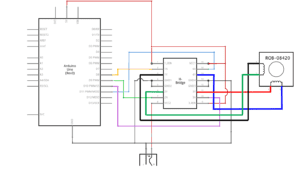components:
For step1 and 2:
1 * 42STH33-0404AC stepper motor
1 * SN754410NE ic chip
1 * power jack
1 * 12 VDC power supply
1 * Arduino kit and its contents
For step3 :
2 * Laser-cut short arms
2 * Laser-cut long arms
1* Laser-cut motor holder
2 * 3D printed motor coupling
5 * Paper Fasteners
1 * Pen that fits the laser-cut mechanisms
Paper
Step 1: Build the circuit

Process: This circuit could be one of the most complicated ones I’ve faced with. And I was actually quite stressful when building it, especially after hearing that we would work with higher voltages this time, which means I will put my Arduino and my laptop in danger in some ways. I built my circuit according to the schematic given and plugged it to my laptop. Then the screen of my laptop turned all black. I was completely shocked and so scared that if I burnt my laptop. Luckily, I restarted the laptop and it still worked. I referred to my partner’s circuit and found out that I connected the voltage and ground incorrectly. Then I checked the connection of the circuit and tried to run the code again. But the port could not be found anymore. I met this problem before so I reopened Arduino. Unfortunately, it didn’t work this time. I turned to Young and he pointed out that maybe I burn the Arduino. OK I really didn’t want to admit this but the circuit worked with another Arduino I borrowed from EC.
Step 2: Control rotation with a potentiometer
Process: Because we only need to add a potentiometer to the circuit, so this step is not hard. I referred to the guidance of the connection of potentiometer and ran the code after modifying the number and using the function “map()”. In order to make the output more obvious, I got some tape from Marcela.
Step 3: Build a Drawing Machine!
Process: I paired up with Amily and successfully built a drawing machine on our own. One small problem id that the machine was not stable enough and sometimes couldn’t exactly draw on the paper because of the height between the pen and paper was changing. We tried to add something under the paper to make it more balanced. The machine was quite energetic and didn’t listen to us. Both of us had no idea what was drawn but it looked artistic.
Question 1:
What kind of machines would you be interested in building?Add a reflection about the use of actuators, the digital manipulation of art, and the creative process to your blog post.
I think I would be interested in building a machine which can monitor how individual spend their time in daily life and help to make better plans for their lives accordingly. I feel like these days, more and more people tend to be restricted by their work and study. They seldom have time to explore and develop their hobbies and specialty. I think this is a big problem. So the machines I want to build can follow the user’s daily routine, have the user to complete some surveys and help to discover the user’s potential ability and interests. I’m not sure about the exact meaning of the use of actuators here. But I assume that the machine is based on the data it collects and does the analysis by artificial technology. Every action taken by the user is the raw data for the machine and it could also be the motive. The digital manipulation pf art is really amazing. Though I’m not good at it. It can basically turn anything in your head into something real. So I feel like that the idea is important, but also the skills in the digital manipulation of art. In any project, one of the key steps is to come up with the creative idea. I believe that a good useful machine’s birth corresponds to a real problem exists in our life. So being creative and trying to figure out a new way to solve it is important.
Question 2:
Choose an art installation mentioned in the reading ART + Science NOW, Stephen Wilson (Kinetics chapter). Post your thoughts about it and make a comparison with the work you did during this recitation. How do you think that the artist selected those specific actuators for his project?
About the art installation Waves, I find that there’s something similar to the drawing machine we did in the recitation. They are both devices that can respond to people’s action. Although we can use the potentiometer or change the state of stillness or chaotic, their reactions and movements are not controlled by us. This is one of the most interesting parts that they attract me. The unknown implies countless possibilities. People’s states of stillness or chaotic are the actuators for the projects. this is the small thing that we seldom care about in our daily life. The artist catches this detail and enlarges it. This can bring people a fresh experience.